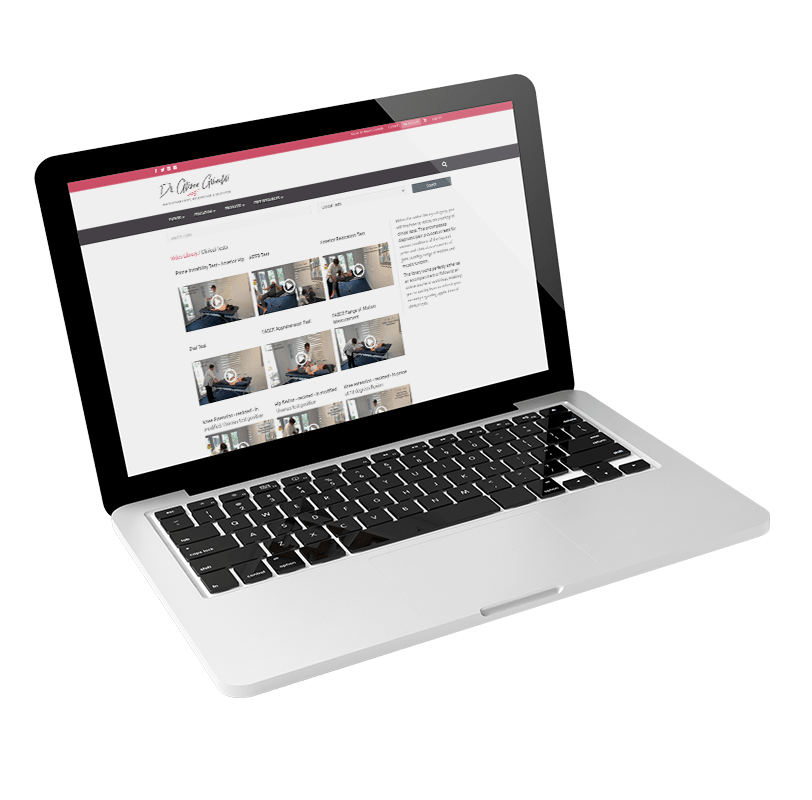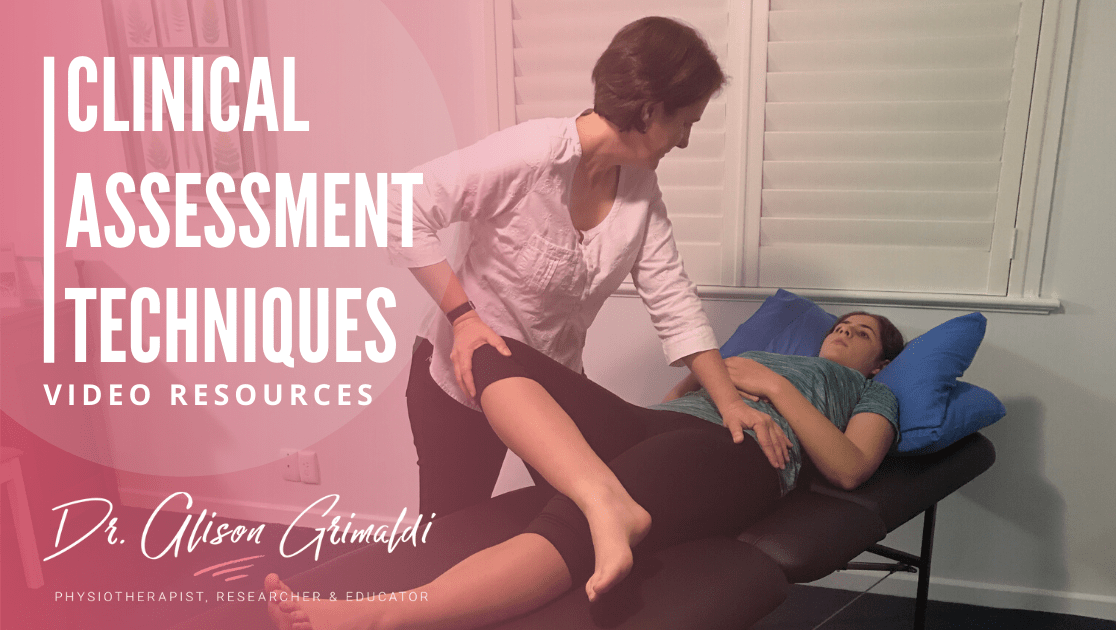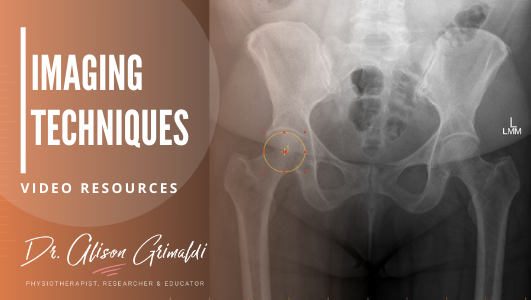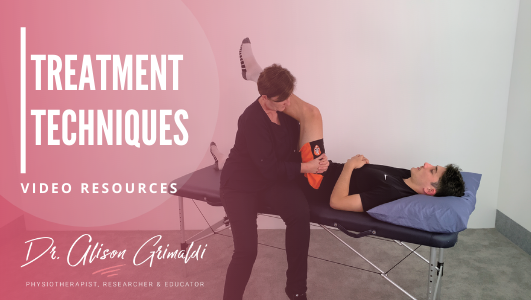Specific Exercise Techniques
Video & audio instruction for exercise therapy - presented as if for the patient viewer
Function around the hip and pelvis is amazingly multifaceted, allowing incredible feats to be performed by the human body. Unfortunately exercise prescription for those with hip, pelvic and groin pain or dysfunction is often incongruently simplistic or limited, failing to address important components of function.
To optimise rehabilitative outcomes and performance, exercise should be targeted to the individual's needs and impairments, while considering any co-existing morphological or pathological constraints. If your exercise repertoire for hip and groin pain consists or a handful of go-to exercises that are applied to all presentations, it might be time to broaden your horizons.
This growing exercise library will provide you with ideas and techniques. View exercises as they would be prescribed to patients. Further knowledge around muscle function is available in the online course Dynamic Stabilisation of the Hip & Pelvis. Application of exercises to specific conditions is discussed in the online courses Anterior Hip and Groin Pain, Lateral Hip and Buttock Pain and the ebook series or print book on tendinopathies of the hip and pelvis. The information below will give you some insights as to what you will receive with your video library subscription.
Hip Flexors
The hip flexors are possibly one of the most demonised groups of muscles in the human body and yet muscles such as the iliacus and iliocapsularis are key muscles for controlling anterior hip joint loads. Hip flexor muscle dysfunction is also associated with hip flexor related pain and most clinical presentations of groin pain. If your exercise repertoire for the hip flexors runs out after stretches, this library will provide many more options for optimising function of the hip flexors. These videos form a great companion to the Anterior Hip and Groin Pain online course or practical workshop.
View a sample below
Hip Abductors
Hip abductor muscle impairment is the most common or consistent impairment seen across a range of joint and soft tissue related hip and groin pain conditions. The hip abductor muscle synergy is critical to single leg weightbearing function. Yet this group of muscles is complex in it's layered arrangement and compilation of multiple muscles exerting their effect via either the greater trochanter or iliotibial band. This synergy may test 'normal' on a strength test and yet exhibit significant dysfunction within synergist muscles. Blanket application of gross strengthening or the 'clamshell' exercise may fail to address specific impairments within the synergy and at worst, make the situation worse. A variety of videos for optimisation of abductor muscle function are showcased in this video library. Further theory behind these exercise approaches are presented in the online course Dynamic Stabilisation of the Hip and Pelvis and application for hip and pelvic conditions are discussed in the Lateral Hip and Buttock Pain online course and the Greater Trochanteric Pain ebook.
View a sample below
Hip External Rotators
The hip external rotator muscles are often overlooked, perhaps due to their depth and lack of confidence in assessment of this specific muscle group. While many general gluteal exercises load the deep external rotator group, certain presentations may need a more specific and targeted approach for deep external rotator conditioning. For example those with pain associated with ligamentum teres tears, posterior joint instability and ischiofemoral impingement may require condition/presentation-specific exercise prescription. These videos are an excellent accompaniment to both the Anterior Hip and Groin Pain and Lateral Hip and Buttock Pain online courses and practical workshops.
View a sample below
Hip Adductors
Exercise for the hip adductor muscle group will be of particular relevance for those with groin pain and/or adductor muscle deficits. While the adductors have a primary frontal/coronal plane action, they also have important roles to play in the sagittal and axial planes. For example, the adductor longus and brevis are hip flexors and the adductor magnus is a hip extensor. For those with groin pain, adductor loading is sometimes best applied in these secondary planes of action to avoid pain provocation particularly in earlier phases of rehabilitation. Rehabilitation of adductor related groin pain is further discussed in the online course Anterior Hip and Groin Pain and also the ebook on this topic.
View a sample below
Functional Lower Limb Loading
There are a large variety of exercises that serve to optimise lower limb weightbearing function. Around the hip, weightbearing is a critical stimulus for the extensors, abductors and external rotators. Weightbearing functional exercise provides a platform to optimise load sharing across the lower kinetic chain by influencing kinematics and muscle recruitment patterns. With improving load tolerance and movement performance, exercise progression and external loading or perturbation can add additional challenge. Functional lower limb loading exercise progressions were a key component of the LEAP trial protocol that demonstrated successful management of gluteal tendinopathy. The library also contains exercises for loading the distal lower kinetic chain.
View a sample below
Bridge Variations
Bridging variations are among the most common exercise prescribed for gluteus maximus conditioning. Yet the way in which a bridge is performed will influence muscle stimulus and outcome. Do you ask your patients to perform a bridge with a posterior pelvic tilt and lumbar flexion? And if so, would you prescribe a squat in the same way? It is important that those prescribing exercise question and understand why an exercise might be performed in a certain manner, rather than just following an exercise 'method'. How a bridge is performed and progressed will determine its effectiveness. More discussion on gluteal exercise is available in the online course Dynamic Stabilisation of the Hip and Pelvis.
View a sample below
Hamstrings
While hamstring muscle exercise jumps immediately to mind in young athletes with hamstring muscle/musculotendinous junction tears, runners and older individuals with proximal hamstring tendinopathy will also require targeted hamstring loading. Further, hamstring weakness and dysfunction is often overlooked in those with global deconditioning and hip extensor deficits. While the gluteus maximus is of key importance, the hamstrings should not be overlooked. How many times due you see a patient experience a hamstring cramp during a bridging exercise or even lifting their heel up behind them. This is often misinterpreted as muscle overactivity, when in most cases this is related to poor muscle capacity. Don't forget to condition those hamstrings! Get some ideas from the videos in this library. Proximal hamstring tendinopathy is discussed in the online course Lateral Hip and Buttock Pain and the ebook on this condition.
View a sample below
Balance & Landing
Balance and landing control are important for both younger athletes and older or deconditioned individuals. It is important that we progress exercises from slow heavy loading, to incorporate dynamic functional tasks at higher speeds and with a rapid eccentric component. The level and rate of progression will be determined by the capacity and specific needs of the individual.
View a sample below
Gym
Heavier loading accomplished in a gym environment may be required by certain athletes or desirable for higher level conditioning and function. This growing library demonstrates exercises that can be performed in the gym by those with hip and pelvic pain, with safe and effective technique.
View a sample below
Dance
Dance is a popular sport or profession, taken up by many at a young age. It is common to see adolescent dancers present with hip and/or groin pain in the context of poor loading habits and conditioning, resulting in focal or global overload. More experienced dancers may present with more subtle impairments but a history of high volume training and/or dancing through pain with associated development of compensatory strategies. Dance specific training is required to address specific functional needs.
View a sample below
Joint Mobility - Neurodynamic Exercise - Stretches
Mobility or ranging exercises can be a useful component of a rehabilitative program when prescribed appropriately, with any morphological or pathological factors considered. For joint related pain, movement is needed for synovial flow and chondral nutrition. For nerve related pain, optimising movement of the nerve through or alongside neighboring structures in positions of low compression, can assist with intraneural fluid flow, health of the nerve and pain reduction. A growing range of exercises for mobility will be added to this video library.
View a sample below
The Ultimate How-To Library

Designed for Physiotherapists, Musculoskeletal Healthcare Practitioners and Exercise Professionals involved in rehabilitation of hip, groin and pelvic pain or dysfunction.
This video library is ONLY available in
Hip Academy Membership



